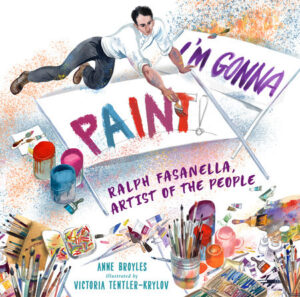7 November 2023
48 pages
—Ryan’s Review of the Writing—
I’m Gonna Paint: Ralph Fasanella, Artist of the People, authored by Anne Broyles and vibrantly illustrated by Victoria Tentler-Krylov, is a welcome children’s picture book that paints a portrait of Ralph Fasanella’s life with the same fervor and detail the artist himself devoted to his canvases. The book captures Ralph’s journey from a tenacious New York kid to an iconic artist, echoing his dedication to portraying the working-class experience.
Broyles’ prose dances between simplicity and evocativeness, achieving a balance that engages young readers while touching on mature themes. For instance, in describing Ralph’s early life, Broyles writes, “Ralph often wandered the city until dinnertime, observing the colors, shapes, and textures of the glowing streetlights against the brick buildings. Instead of going to school, he taught himself how to read by studying newspapers on the subway.” Such language not only builds Ralph’s world but also immerses the reader in the symphony of city life that influenced his art.
Tentler-Krylov’s illustrations must be praised for their dynamism and how they echo Fasanella’s own style—bold, colorful, and brimming with narrative. One can almost feel the texture of the city’s energy in the spread that captures Ralph amidst the clamor and chaos of a labor protest. I’ll let Austin say more about that below in his part.
The narrative deftly weaves Fasanella’s passion for social justice with his artistic development. In a powerful scene, Broyles describes how “It took Ralph three years to create eighteen paintings of workers protesting, union leaders making speeches, militiamen with bayonets, mill owners watching from inside the mills, and more. It was his masterpiece.” This parallel between Ralph’s art and the movement of the American workforce underscores the book’s theme of solidarity and community.
Geared towards children aged 4–8, the book doesn’t shy away from difficult topics like labor rights, instead presenting them through the lens of art and storytelling, making complex concepts a bit more accessible and relatable. The story champions the idea that everyone has the power to create change, aligning with current educational values promoting agency and expression.
In sum, I’m Gonna Paint is an homage to a self-made artist and a call to recognize the beauty and power in one’s own creativity. It’s a vivid reminder of art’s ability to capture and change the zeitgeist, likely resonating with young readers, educators, and parents for its depth and beauty.
4 out of 5 pencils
—Austin’s Review of the Illustrations—
For an illustrator to tackle a children’s book celebrating the life and work of a recognizable modern artist is no simple undertaking. Especially when the artist in question is a primitive whose primary subject matter is a psychological impression of the world in which he grew up. It means that a lot of the reductionist tools an illustrator might use to simplify, streamline, and evoke the spirit of the book’s hero conflict with the journalistic need to echo the subject’s own sensibility; to represent his world, work, and legacy in a specific and recognizable way.
In short, how was Victoria Tentler-Krylov supposed to give us a picture book that looked and felt like the world as artist Ralph Fasanella saw it, and pay homage to that interpretation without directly imitating his style? How, indeed, can a reviewer begin to describe the work of one without comparing and contrasting it with the other? It is reviewing an interpretation of an interpretation. And yet, Tentler-Krylov surmounts this challenge with impressive skill, sensitivity and grace, so I will attempt to follow her example.
As an immigrant son, reform school survivor, and former labor organizer, when Ralph Fasanella became a self-taught painter later in life, he took a forthright and direct approach to create a visual chronicle of the lived experience of the people and the world that he knew, as well as those of his parent’s generation. He drew heavily on the kinds of visual shorthand any illustrator might use to communicate their ideas. X‑ray projections, flattened perspectives, subjective color, expressive as well as descriptive mark-making, and panels that guide the eye through a juxtaposition of scale are all visual syntax a picture book illustrator especially might rely upon regardless of the biographical subject.
Unfazed, Tentler-Krylov supplies many touches of her own that make her vision of Fasanella’s epic world uniquely hers, even as it complements Fasanella’s. Her colors are ever so slightly more naturalistic and objective, her perspective and compositions as grounded as they are whimsical, her focus more sharply moment to moment. Her Van Gogh-esque, Post-Impressionist hatching used with even more deliberate intent. Where Fasanella described the timelessness of a specific world, its moments played out cyclically like the thrum of a thousand sewing machines, Tentler-Krylov gives us specific moments in time surrounding the life of an individual person, and by extension, a hint of the seeds of the artistic vision those experiences would germinate.
Compare the family supper Tentler-Krylov shows us on page 11 with the one Fasanella painted in 1972. Where Fasanella’s depictions of people were hauntingly expressionless, his architecture shaky and his tone somewhat inscrutable beyond the circumstantial, Tentler-Krylov’s settings crackle with life, her dynamic gestures and characterizations sharpened by the wit of a master cartoonist and observer. We can practically smell the bread on the table. Where Fasanella’s compositions are grand and sprawling, Tentler-Krylov’s are as inventive and immediate as any in the medium without ever letting you forget it’s the life of an artist with a very specific vision she’s depicting. In the hands of a lesser illustrator, intimate vignettes like Fasanella stretching canvas or imagining the world he intends to paint as he contemplates the easel wouldn’t have nearly the power they do here.
And as generationally timely as Fasanella’s work was in his era, Tentler-Krylov’s work in this volume is equally so. Especially powerful is the image of Fasanella as a sixty-year-old artist in the 1970s, striding palette in hand through a crowd of striking textile workers in Lawrence Massachusetts circa 1912. Also poignant are the illustrations of modern viewers, swirling in a kind of observational dance around representations of Fasanella paintings. If Fasanella’s work spoke to the power of art to transport a viewer to a time and place and thus keep the lessons of humanity alive, one generation to the next, Tentler-Krylov’s illustrations here do the same. And if Fasanella’s paintings helped in some way to create empathy in viewers for the workers and their families he depicted en masse, Tentler-Krylov’s illustrations create empathy for the scion of a single working family. She shares his tumultuous upbringing with us, and through it the artistic drive, passion, dedication and conscience that gave those workers he championed a voice.
5 out of 5 crayons

Most recently, he illustrated Tales of Mr. Rhee vol. 5: Rockstar Paranoia, a graphic novel, BLAZE ya Dead Homie, a one-shot comic book, and wrote and illustrated RIOT Force, a creator-owned comic series for Source Point Press.


